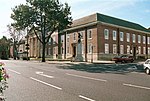Elizabeth Almshouses, Worthing
Almshouses in West SussexBuildings and structures in WorthingListed buildings in West SussexWilliam Burges buildings

The Elizabeth Almshouses are a collection of four almshouses on Elizabeth Road, Worthing built in 1860 by the architect William Burges. The almshouses were paid for by William's father, Alfred Burges, in memory of Alfred's wife. The building is listed Grade II.
Excerpt from the Wikipedia article Elizabeth Almshouses, Worthing (License: CC BY-SA 3.0, Authors, Images).Elizabeth Almshouses, Worthing
Elizabeth Road,
Geographical coordinates (GPS) Address Nearby Places Show on map
Geographical coordinates (GPS)
| Latitude | Longitude |
|---|---|
| N 50.8143 ° | E -0.3774 ° |
Address
Elizabeth Road
Elizabeth Road
BN11 4EF , West Worthing
England, United Kingdom
Open on Google Maps









